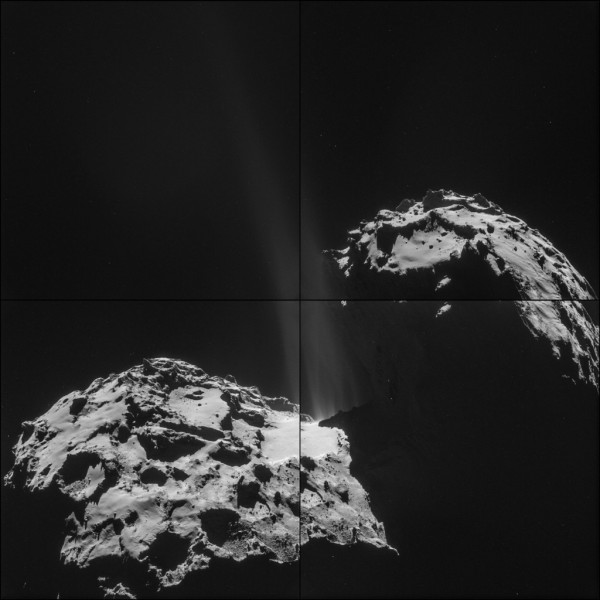Rosetta Captures Intense Jets of Vapor from Comet 67P
| Ana Verayo | | Oct 05, 2014 06:37 AM EDT |
(Photo : ESA/Rosetta/NAVCAM) Four image montage of Comet 67P/C-G on 26 September from a distance of 26.3 km.
The European Space Agency's Rosetta spacecraft observed remarkable activity on Comet 67P/Churyumov-Gerasimenko it's been following while it prepares to launch its lander, Philae, on November 12 to further study the comet's terrain and composition.
On September 26, Rosetta and its navigation cameras captured interesting events that lead to a process called sublimation. Sublimation is mainly caused when a comet approaches the sun and its surface temperatures increase rapidly.
Like Us on Facebook
The comet's surface becomes extremely hot, with the frozen water evaporating immediately into gas due to the extreme heat. Heated ice does not become liquid water in deep space and this is why Comet 67P and other comets releas jets of vapor and gas.
The Rosetta probe observed and documented images of this stunning process of sublimation from a distance of 16 miles from Comet 67P. The jets of vapor appear to emanate from the comet's neck at seven locations while heated ice gases escape from the comet's core.
ESA also noted the comet's image montage isn't consistent since it was extremely challenging to take photos when Comet 67P is rotating between the first and fourth images at an angle of 10 degrees in a span of 20 minutes. Rosetta also had to keep-up with the comet at a distance of one to two kilometers.
Rosetta was launched in 2004 and used Earth and Mars' gravity to propel itself at great distances into deep space. Last August, it finally caught up with Comet 67P as it entered the comet's orbit.
Rosetta will land its space probe, Philae, on November 12. Philae will attach itself to the comet using drills as it studies samples of rock and comet dust.
Scientists believe comets are ancient relics from the birth of the solar system.
TagsRosetta Spacecraft Captures Intense Jets of Vapor from Comet 67P, ESA, european space agency, rosetta comet 67P, 67p comet, 67P photos, sublimation
©2015 Chinatopix All rights reserved. Do not reproduce without permission
EDITOR'S PICKS
-

Did the Trump administration just announce plans for a trade war with ‘hostile’ China and Russia?
-

US Senate passes Taiwan travel bill slammed by China
-

As Yan Sihong’s family grieves, here are other Chinese students who went missing abroad. Some have never been found
-

Beijing blasts Western critics who ‘smear China’ with the term sharp power
-

China Envoy Seeks to Defuse Tensions With U.S. as a Trade War Brews
-

Singapore's Deputy PM Provides Bitcoin Vote of Confidence Amid China's Blanket Bans
-

China warns investors over risks in overseas virtual currency trading
-

Chinese government most trustworthy: survey
-

Kashima Antlers On Course For Back-To-Back Titles
MOST POPULAR
LATEST NEWS
Zhou Yongkang: China's Former Security Chief Sentenced to Life in Prison

China's former Chief of the Ministry of Public Security, Zhou Yongkang, has been given a life sentence after he was found guilty of abusing his office, bribery and deliberately ... Full Article
TRENDING STORY

China Pork Prices Expected to Stabilize As The Supplies Recover

Elephone P9000 Smartphone is now on Sale on Amazon India

There's a Big Chance Cliffhangers Won't Still Be Resolved When Grey's Anatomy Season 13 Returns

Supreme Court Ruled on Samsung vs Apple Dispute for Patent Infringement

Microsoft Surface Pro 5 Rumors and Release Date: What is the Latest?










